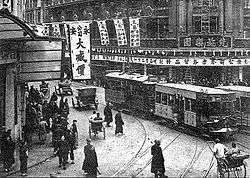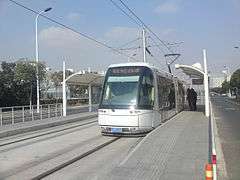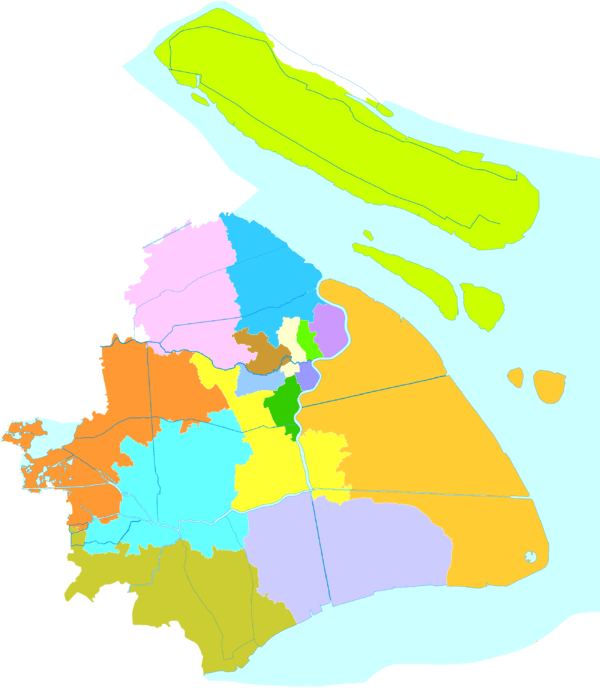Trams in Shanghai
Trams in Shanghai began operating in 1908 using a steel wheeled electric system. In 2010, the Zhangjiang Tram reintroduced this form of transport to Shanghai in the form of a single line in the Zhangjiang Hi-Tech Park in suburban Pudong. Additionally, in 2018 and 2019 two steel wheeled tram lines have opened in Songjiang District.
History


Initial Sections
The first proposal for a tram network in Shanghai was in 1881, Jardine Matheson proposed to the French Concession Board of Directors to open tram services in the French Concession and both parties began planning for a tram network. The Board of Directors adopted the initiative and began planning a tram network.[1]
The first tram line in Shanghai was opened between Jing'an Temple and The Bund on January 21, 1908. The line was 6.04 kilometers long and operated by British commercial interests.[2][3] Later that year the French completed an 8.5 km tram line between The Bund and Xujiahui. In 1912 a locally operated Chinese system opened in Nanshi District.[4]


Three tramway systems
Three tram companies expanded their routes step by step, and collectively reached their maximum extent in 1925 with 328 tramcars and 14 routes. The British system was the largest with seven routes and 216 trams; the French system, had three routes and 60 trams; the Chinese system and operated 52 trams on four routes totaling 23.5 km in length.[5]
During the Japanese occupation of Shanghai in World War II in 1942, the British and French tram systems were placed under the control of the Japanese backed puppet state of the Reorganized Republic of China. During the occupation some tram lines were demolished to support the Japanese war effort. After Japanese surrender in 1945, the tram systems were transferred back to original owners.[2]
During the Korean War, anti-western sentiment and sanctions by the United States made it very difficult for the British and French to operate their respective systems. By 1952 and 1953 the British and French companies were shut down and the three tram systems were consolidated and turned over to local control as part of a mass campaigns of the Communist Party to expel foreign influence.[4] Starting from the late-1960s, the number of buses, taxis and private cars increased rapidly, taking over more streetspace and causing traffic congestion. The congestion greatly affected the quality of tram services and tram lines were gradually dismantled or converted into trolleybus lines. The last tram lines were demolished in 1975.
 1937 Shanghai tram map with all three systems
1937 Shanghai tram map with all three systems 1936 Shanghai tram map
1936 Shanghai tram map 1939 tram map of the Shanghai International Settlement, showing where the routes were disrupted
1939 tram map of the Shanghai International Settlement, showing where the routes were disrupted A map of 1903 showing the built and planned tram routes in the French concession
A map of 1903 showing the built and planned tram routes in the French concession
21st Century
A rubber tired tram opened in Zhangjiang Hi-tech Park in 2010. The Songjiang Tram opened in late 2018.
See also
- Changchun Tram
- Dalian tram
- Hong Kong tram
- Shanghai Metro
- TEDA Modern Guided Rail Tram - rubber tired tram of Tianjin
- Trolleybuses in Shanghai
- Zhangjiang Tram, Shanghai - The second rubber tired tram in Asia
References
- :::: 上海市地方志办公室 上海通网站 上海市地情资料库 上海市的百科全书::::. www.shtong.gov.cn. Retrieved 2017-09-10.
- :::: 上海市地方志办公室 上海通网站 上海市地情资料库 上海市的百科全书::::. www.shtong.gov.cn. Retrieved 2017-09-10.
- 上海市地方志办公室. www.shtong.gov.cn. Retrieved 2017-09-10.
- :::: 上海市地方志办公室 上海通网站 上海市地情资料库 上海市的百科全书::::. www.shtong.gov.cn. Retrieved 2017-09-10.
- Warr, Anne: Shanghai Architecture, The Watermark Press, 2007, ISBN 978-0-949284-76-1

